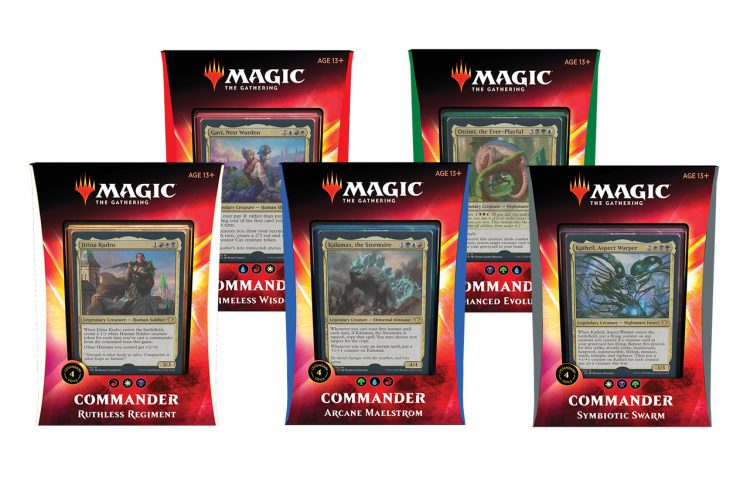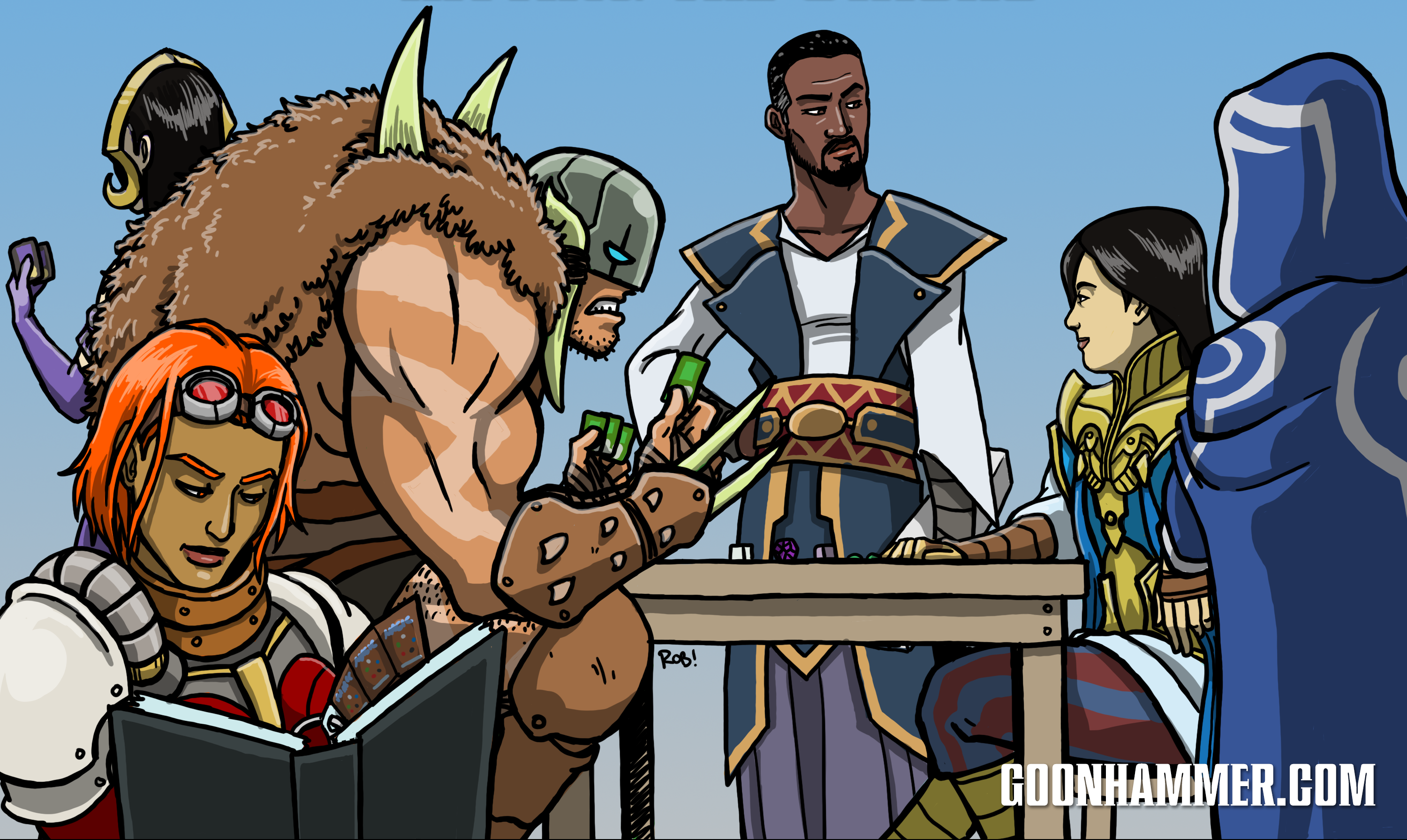Welcome to part three of our Getting Started series for Magic: The Gathering! Yesterday we covered the basics of getting started with Magic: The Gathering Arena electronically (click here if you missed that one and want to know more), and today we’re diving into our first format, talking about how to get started with Commander.
What is Commander?
Commander is Magic: The Gathering’s most popular and fastest-growing format. It was invented (as Elder Dragon Highlander) and popularized by fans and is intended as a casual format that some people play more competitively. You will find it helpful to try out some decks to get a feel for the format and see how it works before you make a decision on building your own, but fortunately most Commander players are very friendly and will happily loan you a deck. Many gaming shops have a regular Commander night, and some offer leagues with objectives you can accomplish in games to score league points aside from simply winning. The defining features that separate Commander from other Constructed formats are:
- In Commander, players use a 99 card deck plus a Legendary Creature (or one of select few Planeswalkers) that is designated as their Commander; this creature isn’t shuffled into the deck but instead resides in a special zone called the Command Zone, from where it can be cast.
- Your Commander defines the ‘color identity’ of your deck which in turn defines what cards can be used in your deck. The mana symbols in its casting cost, or abilities that require a color in the text box, represent that cards’ color identity, which must fit within the colors contained on your Commander. It counts both sides of hybrid mana costs but does not count mana costs in rules reminder text, such as is found on cards with Extort
- Decks may only contain only one copy of a card other than basic lands
- Players start with 40 life
- Taking 21 damage from the same Commander (called “Commander damage”) causes you to lose the game
- Commander is played in multiplayer ‘pods,’ usually consisting of 4 players
If you want to get started owning your own Commander deck there are two routes we’d recommend:
- If you don’t have a large collection of cards, or if you want a good foundation for a deck you further customize, start with a preconstructed Commander deck, or
- If you have a large collection of cards already, you can choose a Legendary creature from your collection as your Commander and begin assembling a deck from among your cards.

Each year Wizards of the Coast releases a “Commander XXXX” set, which consists of four to five 100-card preconstructed Commander-legal decks. Each deck features 3 Legendary ‘face’ creatures as a regular and oversized card (both in foil) to choose between as your Commander, and each deck is organized around a theme. These decks are a really good way to get started in Commander, and unless you have a lot of experience in Magic and an extensive collection, are by far the simplest way to get started. In addition to automatically meeting the requirements of Commander in terms of color identity, these decks will also have appropriate mana bases. Putting together the various flavors of dual lands to optimize your mana base for a Commander deck can be difficult (and expensive) as many of the best dual and tri-color lands are from sets long in the past, while starting with one of these decks gives you a set of lands designed to allow you to have all the colors needed to play the cards in the deck. The decks also contain core cards that usable in any deck, such as Arcane Signet and Command Tower. In the case of the Commander 2020 decks, each deck includes a pair of partners that can be substituted for the Commander, with each pair having the same color identity as the titular commander.
Given one of these decks as a starting base, you can start tinkering with the deck by substituting cards one for one to upgrade it or explore new mechanics. Ultimately you may end up moving away from the initial Commander used for the deck, or the deck can even be retooled with a different Commander with a similar color identity.
Playing Commander
For many players, a multiplayer game can be a new experience. Cards that are functionally the same in single player Magic can have drastic power differences in a four-player setting. Consider the following two very similar cards: Blood Artist and Zulaport Cutthroat. Both cost 1B, but in a four-player game, Zulaport Cutthroat will cause every opponent to lose 1 life every time a creature dies, whereas Blood Artist will only cause one player (of your choice) to lose 1 life. There are pros and cons to both options – obviously Zulaport Cutthroat causes more life loss, but Blood Artist gives you some control over who you are causing to lose life. This can help you with one of the most difficult aspects of the game for many players coming from one on one formats: table politics. Multiplayer game-play encourages players to make deals with each other, broker temporary truces, and gang up on an opponent to balance the table. If one player is obviously ahead or has a deck that is more aggressive, competitive, or threatening due to something like knowing it contains the potential to infinitely combo, a card such as Blood Artist can be used to cause the life loss to that player in order to both reign them in and curry favor with the other players. Conversely, targeted effects can cause some players to attack you or target you in response in order to get revenge for the life loss.
This political element can make games of commander very exciting, but it can also lead to frustrating outcomes if a player feels unfairly targeted or as if other players are incorrectly assessing threats. Some players resent this political gamesmanship and will engage in active retribution against players who engage in table politics while others accept it as part of the game, and still others revel in it. Part of the fun of Commander is exploring how your local group or game store plays and how your local meta functions.
Online Play
If you want to play online, Commander is available in Magic: The Gathering Online. Commander is not available in Magic: The Gathering Arena, however there is an “official” variant in Arena, referred to as Brawl, with similar rules. In addition to Legendary creatures, Brawl allows any Planeswalker as a Commander. Additionally, Brawl decks consist of 60 cards with a limit of 1 for non-basic lands, your starting life total is 25, and Commander damage does not cause you to lose the game (unless your life total drops to zero, anyways). In addition, due to the limitations of the Arena engine, Brawl games are one versus one only, instead of multiplayer.
Some players also play use webcams to play physical paper cards over the internet, and while maintaining board state can occasionally be cumbersome, this also allows geographically diverse or socially distancing players to play together.
Final Thoughts
The fastest and simplest way to get started in Commander is to buy one of the latest years’ Commander decks, take it out for a spin, and then begin tinkering with it. Out of the current crop we recommend Timeless Wisdom, because both Gavi, Nest Warden and the pairing of Brallin, SkyShark Rider and Shabraz, the Skyshark, are strong Commanders that can have good decks built around them, and both have the potential to be played more competitively if you so desire. We’ll do a deeper dive on the mechanics of Commander and how to build a deck in a future article, so if you’re looking for more after your first few games, stay tuned.
Have any questions or feedback? Want to suggest a topic for a future article? Drop a note in the comments below or email us at contact@goonhammer.com.


